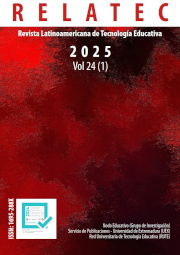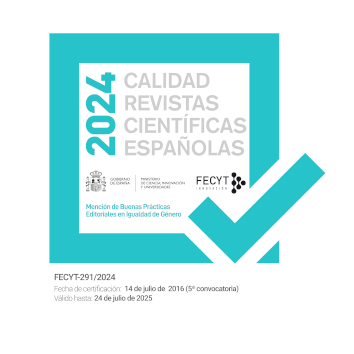El phubbing como norma social: Efectos en el ‘miedo a perderse algo’ (FoMO) y la exclusión percibida
DOI:
https://doi.org/10.17398/1695-288X.24.1.65Palabras clave:
Phubbing, Medo de ficar de fora (FoMO), Isolamento social, Normas sociais, TelemóvelResumen
La tecnología y las redes sociales han transformado nuestra forma de comunicarnos, interactuar y mantenernos informados. Phubbing, en español «Ningufoneo», es un término que proviene de dos palabras «phone» (teléfono) y «snubbing» (desairar) y representa el acto de ignorar a una persona en un entorno de la vida real prestando más atención a su teléfono móvil. Este comportamiento puede estar normalizado o causar dificultades sociales en determinadas situaciones. El objetivo de este estudio fue analizar los niveles de comportamiento normativo y sus relaciones con el FoMO, los sentimientos de exclusión social y la escala de phubbing percibido. Se realizó un estudio transversal, y los participantes fueron 1506 personas en Argentina (50,79% identificadas como mujeres y 49,21% como hombres), con un rango de edad entre 18 y 65 años que completaron una encuesta online. Los resultados confirmaron que el phubbing es percibido como un comportamiento normativo en la mayoría de los participantes, representando un predictor del phubbing en sus interacciones sociales. También se encontraron relaciones entre el phubbing normativo percibido y los niveles de FoMO y sentimientos de exclusión social. Se discuten las implicaciones de las variables estudiadas como posibles predictores del phubbing y que deben tenerse en cuenta en su abordaje. El estudio examina el phubbing como conducta normativa en Argentina. No se han realizado estudios previos que consideren el Miedo a Perderse Algo, los Sentimientos de Exclusión Social y el Phubbing Percibido como variables predictoras.
Descargas
Referencias
Aagaard, J. (2020). Digital akrasia: a qualitative study of phubbing. AI and Society 35(1), 237-244. https://doi.org/10.1007/s00146-019-00876-0
Al-Saggaf, Y., & MacCulloch, R. (2019). Phubbing and social relationships: Results from an Australian sample. Journal of Relationships Research, 10, 10-20. https://doi.org/10.1017/jrr.2019.9
Aljasir, S. (2022). Present but absent in the digital age: testing a conceptual model of phubbing and relationship satisfaction among
married couples. Human Behavior and Emerging Technologies, 1-11. https://doi.org/10.1155/2022/1402751
Blanca, M. J., & Bendayan, R. (2018). Spanish version of the Phubbing Scale: Internet addiction, Facebook intrusion, and fear of missing out as correlates. Psicothema, 30(4), 449-454. https://doi.org/10.7334/psicothema2018.153
Bentler, P. M. (2007). On tests and indices for evaluating structural models. Personality and Individual Differences, 42(5), 825-829. https://doi.org/10.1016/j.paid.2006.09.024
Boniel-Nissim M., Tynjälä, J., Gobiņa, I., Furstova, J., van den Eijnden, R., Marino, C., Klanšček, H.J., Klavina-Makrecka, S., Villeruša, A., Lahti, H., Vieno, A., Wong, S.L., Villberg, J., Inchley, J., Gariépy, G. (2023). Adolescent use of social media and associations with sleep patterns across 18 European and North American countries. Sleep Health, 9(3), 314-321. https://doi.org/10.1016/j.sleh.2023.01.005
Budnick, C. J., Rogers, A. P., & Barber, L. K. (2020). The fear of missing out at work: Examining costs and benefits to employee health and motivation. Computers in Human Behavior, 104, 106161. https://doi.org/10.1016/j.chb.2019.106161
Chotpitayasunondh, Varoth & Douglas, Karen. (2016). How “phubbing” becomes the norm: The antecedents and consequences of snubbing via smartphone. Computers in Human Behavior 63, 9-18. https://doi.org/10.1016/j.chb.2016.05.018
Chotpitayasunondh, Varoth & Douglas, Karen. (2018). The effects of "phubbing" on social interaction. Journal of Applied Social Psychology, 48(6), 304-316. https://doi.org/10.1111/jasp.12506
David, M. E., & Roberts, J. A. (2017). Phubbed and alone: Phone snubbing, social exclusion, and attachment to social media. Journal of the Association for Consumer Research, 2(2), 155-163. https://doi.org/10.1086/690940
David, M.E. & Roberts, J. A. (2020). Developing and testing a scale designed to measure perceived phubbing. International Journal of Environmental Research and Public Health 17(21), 1-15, 8152. https://doi.org/10.3390/ijerph17218152
Daantje Derks, A. B., Bakker, M. G. (2021). Private smartphone use during worktime: A diary study on the unexplored costs of integrating the work and family domains. Computers in Human Behavior, 114, 106530. https://doi.org/10.1016/j.chb.2020.106530
Durao, M., Etchezahar, E., Albalá Genol, M. Á., & Muller, M. (2023). Fear of Missing Out, Emotional Intelligence and Attachment in Older Adults in Argentina. Journal of Intelligence, 11(2), 22. https://doi.org/10.3390/jintelligence11020022
Falk, A., & Fischbacher, U. (2006). A theory of reciprocity. Games and Economic Behavior, 54(2), 293-315. https://doi.org/10.1016/j.geb.2005.03.001
George, D. and Mallery, P. (2010). SPSS for Windows Step by Step: A Simple Guide and Reference 17.0 Update. 10th Edition, Pearson.
Haigh, A. (2015). Stop phubbing. Retrieved from http://stopphubbing.com
Hakoama, M., & Hakoyama, S. (2012). Young adults’ evaluations of cell phone manners. The American Association of Behavioral and Social Sciences Journal, the AABSS Journal, 16, 140-154.
Hall J.A., Baym N.K. and Miltner K.M. (2014). Put down that phone and talk to me: Understanding the roles of mobile phone norm adherence and similarity in relationships. Mobile Media & Communication, 2, 134-153. https://doi.org/10.1177/2050157913517684
Ivanova, A., Gorbaniuk, O., Błachnio, A. (2020). Mobile Phone Addiction, Phubbing, and Depression Among Men and Women: A Moderated Mediation Analysis. Psychiatr Q 91, 655–668. https://doi.org/10.1007/s11126-020-09723-8
Kadylak, T. (2019). Mobile Phone Habits During Face to Face First Encounters: An Investigation of Self-disclosure and Nonverbal Mimicry. Michigan State University. Information and Media.
Keysar, B., Converse, B. A., Wang, J., & Epley, N. (2008). Reciprocity is not give and take: asymmetric reciprocity to positive and negative acts. Psychological Science, 19(12), 1280e1286. http://dx.doi.org/10.1111/j.1467-9280.2008.02223.x
Khan, M. (2008). Adverse effects of excessive mobile phone use. International Journal of Occupational Medicine and Environmental Health, 21(4), 289-293. http://dx.doi.org/10.2478/v10001-008-0028-6
Krasnova H., Abramova O., Notter I., & Baumann A. (2016). Why phubbing is toxic for your relationship: Understanding the role of smartphone jealousy among ‘Generation Y’ users. Paper presented at the 24th European Conference on Information Systems (ECIS), Istanbul, Turkey.
Koebner, I. J., Fishman, S. M., Paterniti, D., Sommer, D., Witt, C. M., Ward, D., & Joseph, J. G. (2018). The Art of Analgesia: A Pilot Study of Art Museum Tours to Decrease Pain and Social Disconnection Among Individuals with Chronic Pain. Pain Medicine, 20(4), 681–691. https://doi.org/10.1093/pm/pny148
Leuppert, R., & Geber, S. (2020). Commonly done but not socially accepted? Phubbing and social norms in dyadic and small group settings. Communication Research Reports, 37(3), 55-64. https://doi.org/10.1080/08824096.2020.1756767
Li, Y.-X., Zhang, Y.-H., Yang, R., Lian, S.-L., Yan, L., & Zhu, X.-M. (2023). Relationship between Perceived Social Norms and Phubbing: Individual Control and Fear of Missing Out as Mediators. International Journal of Mental Health and Addiction, 21, 1898–1913. https://doi.org/10.1007/s11469-021-00696-8
Miller, D. T., & Prentice, D. A. (1996). The construction of social norms and standards. In E. T. Higgins & A. W. Kruglanski (Eds.), Social psychology: Handbook of basic principles (pp. 799–829). The Guilford Press.
Pancani, L., Marinucci, M., Aureli, N., & Riva, P. (2021). Forced social isolation and mental health: A study on 1006 Italians under COVID-19 quarantine. Frontiers in Psychology, 21(12), 663799. https://doi.org/10.3389/fpsyg.2021.663799
Przybylski, A. K., Murayama, K., DeHaan, C. R., & Gladwell, V. (2013). Motivational, emotional, and behavioral correlates of missing out. Computers in Human Behavior, 29(4), 1841-1848. https://doi.org/10.1016/j.chb.2013.02.014
Ranie, L., & Zickuhr, K. (2015). Americans’ Views on Mobile Etiquette. Pew Research Center.
Rendón Vélez, L. J. (2022). El phubbing y las relaciones de pareja adulta. Poiésis, 42, 49-61. https://doi.org/10.21501/16920945.3792
Roberts, J. A., & David, M. E. (2019). The Social Media Party: Fear of Missing Out (FoMO), Social Media Intensity, Connection, and Well-Being. Int. J. Hum.-Comput. Interact, 36, 386–392. https://doi.org/10.1080/10447318.2019.1646517
Sunstein, C. R. (1996). Social norms and social roles. Columbia Law Review, 2, 903-968. http://dx.doi.org/10.2307/1123430
Tandon, A., Amandeep D., Shalini T., Puneet K., & Matti M. (2021). Dark consequences of social media-induced fear of missing out (FoMO): Social media stalking, comparisons, and fatigue. Technological Forecasting and Social Change, 171, 120931. https://doi.org/10.1016/j.techfore.2021.120931
Turel, O., Matt, C., Trenz, M., Cheung, C.M.K., D’Arcy, J., Qahri-Saremi, H. & Tarafdar, M. (2019). Panel report: the dark side of the digitization of the individual. Internet Research, 29(2), 274-288. https://doi.org/10.1108/INTR-04-2019-541
Téllez Rojas, M. A., & Rivera Fong, L. (2020). Development and validation of an instrument to measure social exclusion perception in young people. Psicogente, 23, 144-166. https://doi.org/10.17081/psico.23.43.3294
Vanden Abeele, M. M. P. (2018). The social consequences of phubbing: A framework and a research agenda. In R. S. Ling, L. Gogging, S. S. Fortunati, & Y. Li (Eds.), Handbook of mobile communication, culture, and information (pp. 158-174). Oxford University Press.
Yousaf, S., Rasheed, M. I., Hameed, Z., & Luqman, A. (2019). Occupational stress and its outcomes: The role of work-social support in the hospitality industry. Personnel Review, 49(3), 755–773. https://doi.org/10.1108/PR-11-2018-0478
Yousaf, S., Muhammad, I. R., Puneet, K., Nazrul, I., & Amandeep, D., (2022). The dark side of phubbing in the workplace: Investigating the role of intrinsic motivation and the use of enterprise social media (ESM) in a cross-cultural setting. Journal of Business Research, 143, 81-93. https://doi.org/10.1016/j.jbusres.2022.01.043.
Williams K. D., Cheung C., & Choi W. (2020). Cyberostracism: Effects of being ignored over the Internet. Journal of Personality and Social Psychology, 79(5), 748-762. https://doi.org/10.1037//0022-3514.79.5.748
Zhang, Z., Jiménez, F. R., & Cicala, J. E. (2020). Fear of Missing Out Scale: A self-concept perspective. Psychology and Marketing, 37(11), 1619-1634. https://doi.org/10.1002/mar.21406
Descargas
Publicado
Número
Sección
Licencia
Derechos de autor 2025 Miguel Ángel Albalá-Genol, Edgardo Etchezahar, Talía Gómez-Yepes, Joaquin Ungaretti

Esta obra está bajo una licencia internacional Creative Commons Atribución-NoComercial-SinDerivadas 4.0.
Los autores/as que publiquen en esta revista aceptan las siguientes condiciones:
1. Los autores/as conservan los derechos de autor y ceden a la revista el derecho de la primera publicación, con el trabajo registrado con la licencia Creative Commons Reconocimiento-NoComercial-SinObraDerivada 4.0 International (CC BY-NC-ND), que permite a terceros utilizar lo publicado siempre que mencionen la autoría del trabajo y a la primera publicación en esta revista.
2. Los autores/as pueden realizar otros acuerdos contractuales independientes y adicionales para la distribución no exclusiva de la versión del artículo publicado en esta revista (p. ej., incluirlo en un repositorio institucional o publicarlo en un libro) siempre que indiquen claramente que el trabajo se publicó por primera vez en esta revista.
3. Se permite y recomienda a los autores/as a publicar su trabajo en Internet (por ejemplo en páginas institucionales o personales) antes y durante el proceso de revisión y publicación, ya que puede conducir a intercambios productivos y a una mayor y más rápida difusión del trabajo publicado (vea The Effect of Open Access).









